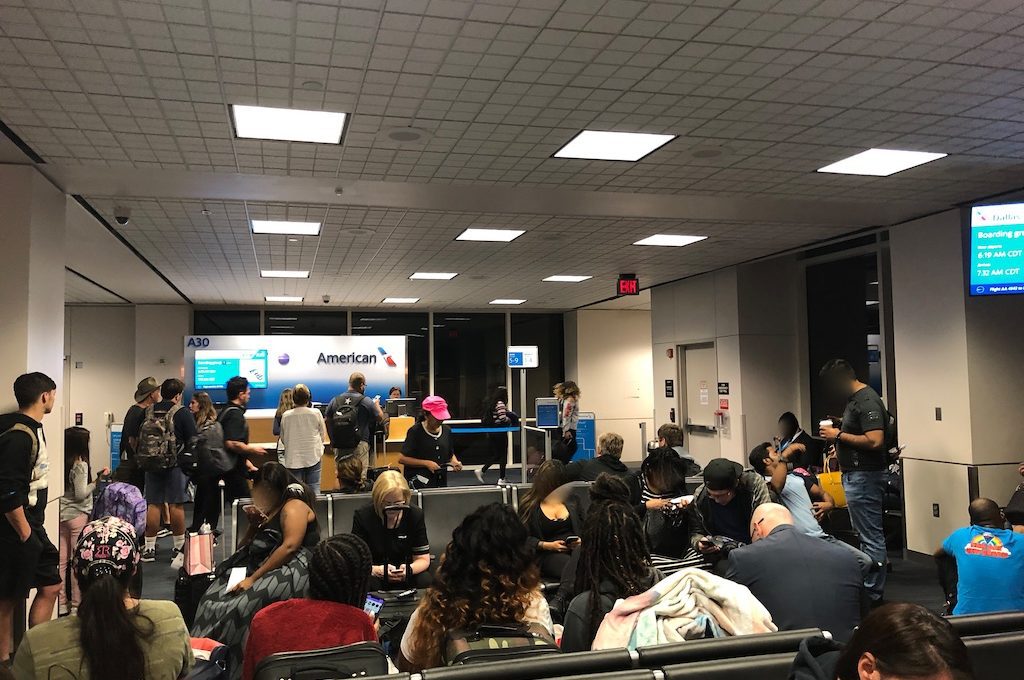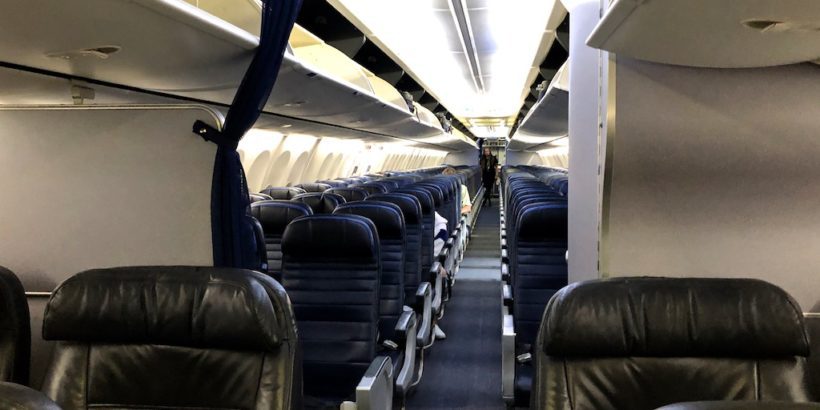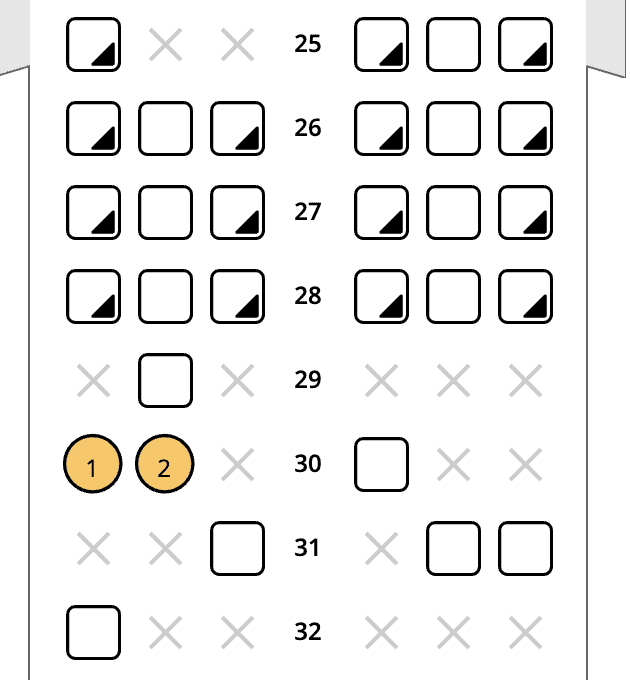Knowing if your flight is going to be full can be very helpful for people who have special requests or are just curious as to what to expect on the flight.
The problem is airlines don’t like to divulge this information so sometimes you have to go about getting it in roundabout ways using “circumstantial evidence” to help you guesstimate how full the flight is.
Below, I will give you several different methods you can try out to help figure out how full your plane is.
Some are more helpful than others but by giving each of these a try, you can often make an educated guess on how full your flight is going to be.
Table of Contents
Ask the check-in or gate agent
Whenever you arrive at the check-in desk or at the gate, you can ask an airline employee if your flight is going to be full.
The trick to doing this is to make sure that you clarify that you want to know if there will be any open seats.
That’s important because a lot of times an agent will announce that the “flight is full today” but when they say that they really mean something like 95% full. In other words, there still will be some open seats.
(They sometimes do that to “scare” people into gate checking their carry-on bags so that the boarding process will be smoother.)
In some cases, an agent might be able to tell you exactly how many seats are still available but in other cases it might be more of an estimate.
Just keep in mind that the seat inventory of your flight can change very close to the time of departure if other flight changes and cancellations occur. So if you check with the agent at the gate 30 minutes prior to departure, it’s very possible that things could change in the next 20 minutes.

Call the airline
If you want to check on the flight status before you arrive at the airport or even when you are at the airport, you can also call the airline, give them your booking reference number, and see if they can give you information about how full the flight is.
Sometimes you might want to throw in some additional context like you’re concerned about sitting next to other passengers for some type of medical reason or whatever. That’s because it might motivate the agent to be a little bit more diligent.
If you sense the agent is not being helpful or is just being flat out lazy, consider calling back and speaking with another agent who might be more willing to assist.
They may not be able to tell you down to the exact passenger number how filled the cabin is but they should be able to give you an estimate.
For example, whenever I called United Airlines and inquired about a flight itinerary with two segments, the agent was able to look into both flights and tell me that the flights were about “20 something percent” full.
This is an easy way to verify if the flight is full but because things can change so quickly it’s not the most helpful way to know for sure that there will be open seats unless you are calling just before departure time.
Check upgrade and standby lists
Some airlines will display seat inventory in the upgrade and standby lists. For example, Delta is good about this for First Class and Comfort Plus.
This is typically something you would only check just before departure so it’s not going to be helpful several weeks out.
Related: Why You Should (And Shouldn’t) Check in Online for Flights
Attempt a large booking
Another way to estimate how full a flight is going to be is to simply attempt a large booking.
For example, if you are wondering if there will be five open seats then simply try to go through the booking process when selecting five passengers for the trip.
You’ll need to input details for those passengers and you obviously want to stop before the final check out but this can be a relatively quick way to check on existing inventory. Just remember that some flights do oversell!
Check the fare buckets
Checking the fare buckets can also give you an indication of how many seats are available but it gets confusing for a lot of people, especially beginners.
Airline tickets are grouped into different buckets to help determine things like price, change policies, upgrades, etc.
When you are searching for flights, you might see something like “J3” for the business class J fare. This would mean that there are three business class seats available.
But it gets a little confusing for a few reasons….
One is that there is overlap between the fare buckets. For example, a Y bucket is usually the most expensive type of economy bucket and something like G may be a cheaper economy bucket.
When looking at economy inventory, if you see Y6 and G4, that does not mean there are ten economy seats left.
It just means that six seats can be booked in the most expensive bucket and four could be booked in the cheaper bucket.
You could also infer that there are at least six economy tickets since that is the number associated with the highest fare for that class (“Y”).
Confused?
This example may clear it up.
In the example above, assume three G seats were sold. The fare bucket numbers would change from Y6 and G4 to Y3 and G1.
If 3 Y seats were sold, Y would change to Y3 and G could drop to G1.
Another thing that trips people up is that the number associated with a fare bucket may also be smaller than the number of fares actually available. For example, the highest Y number you see may be 9 (Y9) but there could actually be many more Y fares. Airlines just don’t want to publish that data to keep a competitive edge.
The other thing to keep in mind is that airlines oversell tickets. So they may have eight slots showing as available for a given fare bucket but there may actually only be seven seats available.
As you can tell, knowing how to rely on fare buckets is not easy and takes a bit of experience but if you want to take this approach a step further you can also utilize something like Expert Flyer to help you out.
Check the seat map
Another way to check on how filled the flight is going to be is to check the seat map.
Finding a seat map is usually pretty easy. You simply act like you are going through the booking process on an airline’s website, and you should be able to access the seat map at some point.
Seat maps can be notoriously unreliable though.
That’s because they don’t always accurately reflect which seats are taken. Many people do not choose their seat or get assigned their seat until close to check-in. So seats will remain open even though someone will be filling it.
It would not be uncommon to see dozens of open seats a couple of days before the flight only to find that almost all those seats are taken up once the majority of passengers have checked in.
Sometimes agents will shuffle around passengers who have special requests. For example, a family might ask to be seated together. Those type of requests mean that an empty seat next to you could become occupied at the last minute.
So while the seat maps can help give you an idea of capacity they often are not the best way to predict how full your flight is going to be until you are very close to departure.
Related: How Much It Costs to Choose Your Seats on Each Airline
Talk to flight attendants
Another good method is to speak to a flight attendant as you are boarding the flight. Once again, make sure you clarify that you want to know if the flight is 100% full.
If you have a particular needs such as wanting to sit with your child you could voice those to a flight attendant and they may be able to help you spot available seats. Just remember that they have a job to do so if they can’t tend to your requests, be understanding.
Related: Switching Seats on a Plane? Etiquette Tips for Getting “Yes” and Saying “No”
Check the news
What does the news have to do with how full your flight is?
If you’ve seen a lot of articles popping up about flight cancellations and delays, perhaps due to bad weather or to ongoing strikes, shortages, etc., there’s a good chance that flights will be fuller than usual.
This is even the case if the cancellations are happening at another airport.
That’s because such circumstances could cause connecting flights to be re-routed. If those flights are re-routed to where you are departing from, all of the empty seats on your flight could easily be filled.
And if you happen to find out that a prior flight from your departure city to your destination has been canceled, you can usually assume that your flight will be full.
This is one of the benefits of booking a super early flight. There are fewer opportunities for other cancellations and changes to cause your flight to fill up.
Final word
In the end, it’s often difficult to know if your flight will be full until you get very close to departure. That’s because many different variables can dictate if your flight will fill up and you can’t always predict those. But if your flight is going to be full days or weeks outside of departure, these methods can help you figure that out.
Daniel Gillaspia is the Founder of UponArriving.com and the credit card app, WalletFlo. He is a former attorney turned travel expert covering destinations along with TSA, airline, and hotel policies. Since 2014, his content has been featured in publications such as National Geographic, Smithsonian Magazine, and CNBC. Read my bio.



You missed the only accurate way to check the number of open seats: the StaffTraveler app!